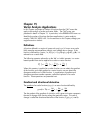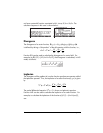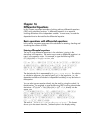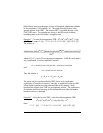
Page 15-6
As an example, in an earlier example we attempted to find a potential function
for the vector field F(x,y,z) = (x+y)i + (x-y+z)j + xzk, and got an error message
back from function POTENTIAL. To verify that this is a rotational field (i.e., ∇×F
≠ 0), we use function CURL on this field:
On the other hand, the vector field F(x,y,z) = xi + yj + zk, is indeed irrotational
as shown below:
Vector potential
Given a vector field F(x,y,z) = f(x,y,z)i+g(x,y,z)j+h(x,y,z)k, if there exists a
vector function Φ(x,y,z) = φ(x,y,z)i+ψ(x,y,z)j+η(x,y,z)k, such that F = curl Φ = ∇
×Φ, then function Φ(x,y,z) is referred to as the vector potential
of F(x,y,z).
The calculator provides function VPOTENTIAL, available through the command
catalog (‚N), to calculate the vector potential, Φ(x,y,z), given the vector
field, F(x,y,z) = f(x,y,z)i+g(x,y,z)j+h(x,y,z)k. For example, given the vector
field, F(x,y,z) = -(yi+zj+xk), function VPOTENTIAL produces
i.e., Φ(x,y,z) = -x
2
/2j + (-y
2
/2+zx)k.
It should be indicated that there is more than one possible vector potential
functions Φ for a given vector field F. For example, the following screen shot
shows that the curl of the vector function Φ
1
= [X
2
+Y
2
+Z
2
,XYZ,X+Y+Z] is the
vector F = ∇× Φ
2
= [1-XY,2Z-1,ZY-2Y]. Application of function VPOTENTIAL


















